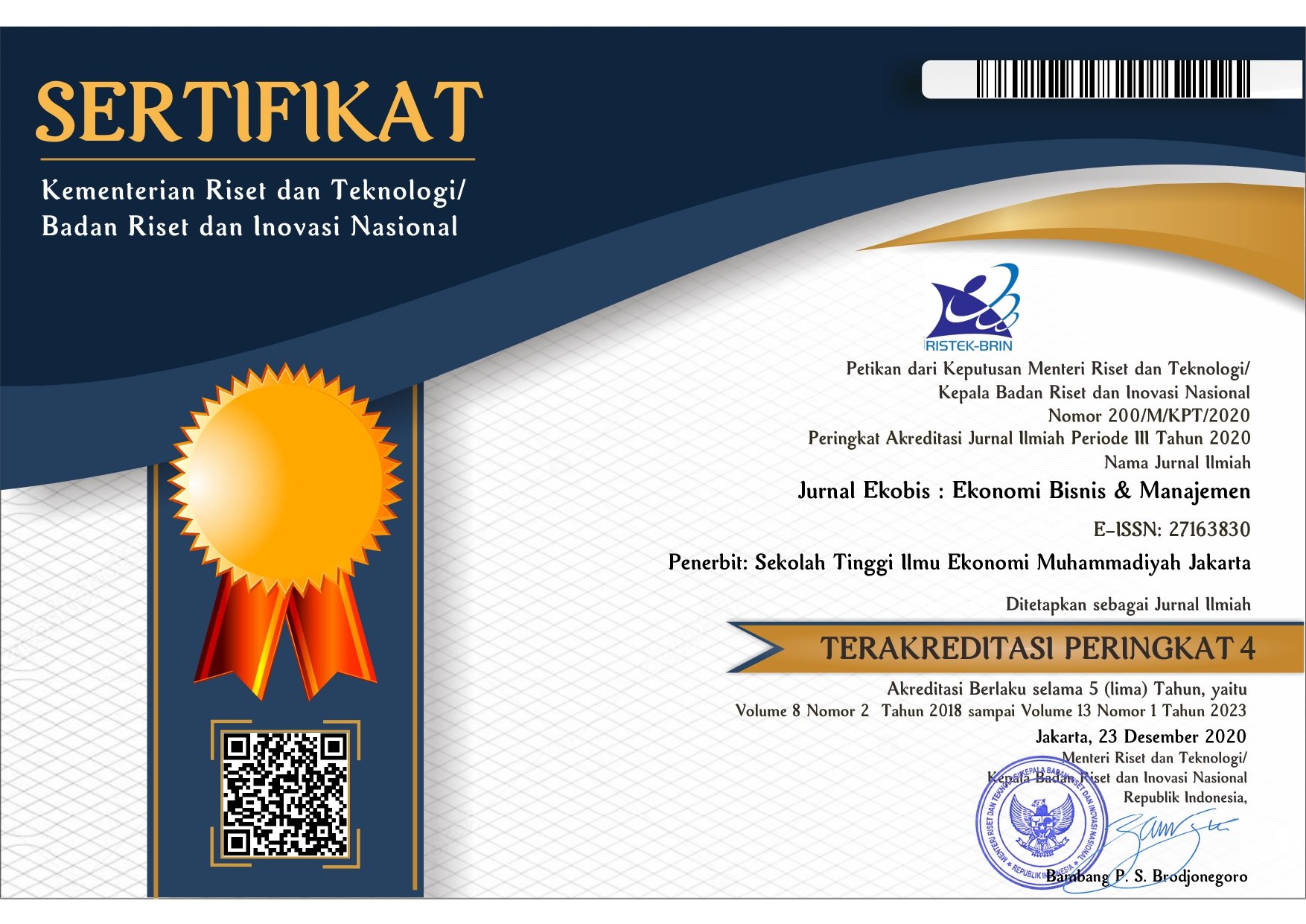EFEKTIVITAS REZIM INFLATION TARGETING FRAMEWORK (ITF) TERHADAP INFLASI DI INDONESIA
DOI:
https://doi.org/10.37932/j.e.v10i2.105Keywords:
Nilai Tukar, Jumlah Uang Beredar, Inflasi Periode Sebelumnya, Inflation Tagreting Framework, InflasiAbstract
Sebagai otoritas moneter, Bank Indonesia diberi amanat oleh pemerintah untuk menjaga stabilitas nilai rupiah melalui rezim Inflation Targeting Framework. Meskipun kebijakan Inflation Targeting Framework telah dijalankan sejak tahun 2005, nyatanya, target inflasi baru dicapai secara konsisten pada empat tahun terakhir, dari 2015 sampai dengan 2018. Penelitian ini bertujuan menguji efektivitas kerangka kebijakan moneter yang sedang dijalankan oleh Bank Indonesia. Variabel yang digunakan dalam penelitian ini adalah Nilai Tukar Rupiah/USD, Jumlah Uang Beredar dalam arti sempit (M1), Inflasi Periode Sebelumnya, Dummy Inflation Targeting Framework sebagai variabel independen, dan Inflasi sebagai variabel dependen. Data yang digunakan adalah data tahunan dari tahun 1991 sampai dengan2018. Sedangkan metode penelitian ini adalah regresi berganda menggunakan Huber-White dengan bantuan E-views 9.0. Hasil penelitian menujukkan bahwa Nilai Tukar Rupiah/USD, Jumlah Uang Beredar, Inflasi Periode Sebelumya berpengaruh positif dan signifikan terhadap Inflasi. Selain itu, hasil penelitian juga menunjukkan bahwa Dummy Inflation Targeting Framework berpengaruh signifikan terhadap Inflasi.References
Agung, J., Astiyah, S., Sukowati, E., Prastowo, N. J., Muttaqin, M. F., & Ismal, R. (2001). Identifikasi Variabel Informasi Dalam Framework Inflation Targeting. (2000), 59–77.
Algifari. (2015). Analisis Regresi Untuk Bisnis dan Ekonomi (Third). Yogyakarta: BPFE.
Aprileven, H. P. (2013). Pengaruh Faktor Ekonomi Terhadap Inflasi Yang Dimediasi Oleh Jumlah Uang Beredar. EDAJ: Economics Development Analysis Journal, 2(4), 446–455.
Bernanke, B. S., & Mishkin, F. S. (1997). Inflation Targeting: A New Framework for Monetary Policy? In Journal of Economic Perspectives (Vol. 11). https://doi.org/10.1257/jep.11.2.97
Berry, S., Harrison, R., Thomas, R., & De Weymarn, I. (2007). Interpreting Movements in Broad Money. Bank of England Quarterly Bulletin, Q3, 376–388. Retrieved from http://papers.ssrn.com/abstract=1017232
Carare, A., & Stone, M. . (2003). Inflation Targeting Regimes (No. WP/03/9).
Debelle, G., & Fischer, S. (1995). How Independent Should A Central Bank Be? In J. Fuhrer (Ed.), Goals, Guidelines and Constraints Facing Monetary Policymakers (pp. 195–221). Boston.
Dewayany, H. P. (2012). ANALISIS PENGARUH FLUKTUASI NILAI TUKAR RUPIAH PASACA PENERAPAN “NILAI TUKAR MENGAMBANG TERKENDALI” DAN IMPLIKASI PENERAPAN INFLATION TARGETING FRAMEWORK (ITF) TERHADAP INFLASI DI INDONESIA. Universitas Indonesia, Jakarta.
Edwards, S. (2006). The Relationship Between Exchange Rates And Inflation Targeting Revisited. In Working Paper 12163 (No. 12163). https://doi.org/10.1016/0022-1996(78)90025-9
Erceg, C. J., & Levin, A. T. (2003). Imperfect credibility and inflation persistence. Journal of Monetary Economics, 50(4), 915–944. https://doi.org/10.1016/S0304-3932(03)00036-9
Hakim, R., Ismail, M., & Hoetoro, A. (2017). Kredibilitas Bank Sentral Dan Persistensi Inflasi Di Indonesia. EKUITAS (Jurnal Ekonomi Dan Keuangan), 17(2), 155. https://doi.org/10.24034/j25485024.y2013.v17.i2.2237
Ismail, M. (2006). Inflation Targeting Dan Tantangan. Jurnal Ekonomi Dan Bisnis Indonesia, 21(2), 105–121.
Koku, P. S., Caushi, A., Fetai, A., & Fetai, B. (2016). The relationship between exchange rate and inflation: the case of Western Balkans Countries. Pressacademia, 5(4), 360–364. https://doi.org/10.17261/pressacademia.2017.358
Latumaerissa, J. R. (2011). Bank dan Lembaga Keuangan Lain. Jakarta: Salemba Empat.
Liu, H. Y., & Chen, X. L. (2017). The imported price, inflation and exchange rate pass-through in China. Cogent Economics and Finance, 5(1). https://doi.org/10.1080/23322039.2017.1279814
Monfared, S. S., & Akın, F. (2017). the Relationship Between Exchage Rates and Inflation: the Case of Iran. European Journal of Sustainable Development, 6(4), 329–340. https://doi.org/10.14207/ejsd.2017.v6n4p329
Musa, S. (2008). Membedah Krisis Perbankan. Jakarta: SAD Satria Bhakti.
Ningsih, S., & Kristiyanti, L. (2018). Analisis pengaruh jumlah uang beredar, suku bunga, dan nilai tukar terhadap inflasi di indonesia periode 2014-2016. Jurnal Ekonomi Manajemen Sumber Daya, 20(2), 96–103.
Rachman, F. (2015). "Does Inflation Targeting Framework Make a Significant Difference in Lowering Price Level?” What is Its Implication to Indonesia’s Inflation Rate? Economics and Finance in Indonesia, 61(2), 131. https://doi.org/10.7454/efi.v61i2.508
Salvatore, D. (1997). Ekonomi Internasional. Jakarta: Erlangga.
Setiawan, A. (2011). INFLATION TARGETING FRAMEWORK DAN PERUBAHAN RESPON KEBIJAKAN MONETER. Universitas Indonesia, Jakarta.
Sukirno, S. (2004). Pengantar Teori Makroekonomi. Jakarta: PT Raja Grafindo Persada.
Vega, M., & Winkelried, D. (2005). “Inflation Targeting and Inflation Behavior : A Successful Story ?” International Journal of Central Banking, 1(3), 153–175.
Widarjono, A. (2018). Ekonometrika Pengantar dan Aplikasinya Disertai Panduan Eviews. Yogyakarta: UPP STIM YKPN.
Downloads
Additional Files
Published
How to Cite
Issue
Section
License
Copyright Notice
Copyright
Authors retain copyright and grant the journal right of first publication with the work simultaneously licensed under a Creative Commons Attribution-ShareAlike 4.0 International License that allows others to share the work with an acknowledgment of initial publication in this journal.
Authors are permitted and encouraged to post their work online (e.g., in institutional repositories or on their website) before and during the submission process, as it can lead to productive exchanges and earlier and greater citation of published work (See The Effect of Open Access).
License
You are free to:
- Share — copy and redistribute the material in any medium or format
- Adapt — remix, transform, and build upon the material
- for any purpose, even commercially.
Under the following terms:
-
Attribution — You must give appropriate credit, provide a link to the license, and indicate if changes were made. You may do so in any reasonable manner, but not in any way that suggests the licensor endorses you or your use.
-
ShareAlike — If you remix, transform, or build upon the material, you must distribute your contributions under the same license as the original.
- No additional restrictions — You may not apply legal terms or technological measures that legally restrict others from doing anything the license permits.
Jurnal Ekobis: Ekonomi Bisnis & Majemen is licenced under Creative Commons Attribution-ShareAlike 4.0 International (CC BY-SA 4.0).
Privacy Statement
The names and email addresses entered in this journal site will be used exclusively for the stated purposes of this journal and will not be made available for any other purpose or to any other party.



